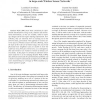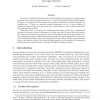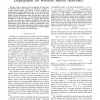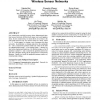346 search results - page 44 / 70 » Redundant Coverage in Wireless Sensor Networks |
WOWMOM
2009
ACM
14 years 2 months ago
2009
ACM
Random Walks (RWs) have been considered for information dissemination in large scale, dynamic and unstructured environments, as they are scalable, robust to topology changes and d...
WIOPT
2010
IEEE
13 years 6 months ago
2010
IEEE
—The nodes in wireless sensor networks often collect correlated measurements. Not taking into account this information redundancy is detrimental to the network lifetime, since co...
ALGOSENSORS
2007
Springer
13 years 12 months ago
2007
Springer
We study the problem of localizing and tracking multiple moving targets in wireless sensor networks, from a network design perspective i.e. towards estimating the least possible n...
INFOCOM
2006
IEEE
14 years 1 months ago
2006
IEEE
— Before a sensor network is deployed, it is important to determine how many sensors are required to achieve a certain coverage degree. The number of sensor required for maintain...
MOBIHOC
2009
ACM
14 years 2 months ago
2009
ACM
Low-connectivity and full-coverage three dimensional Wireless Sensor Networks (WSNs) have many real-world applications. By low connectivity, we mean there are at least k disjoint ...




